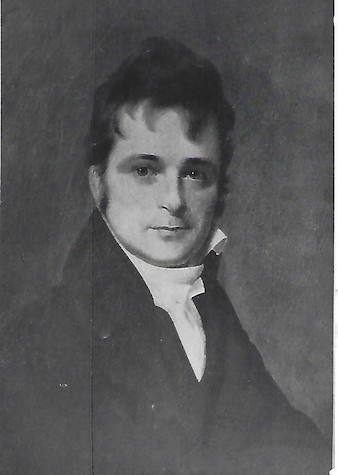Bates, Nancy
The Second “First Lady” of Missouri
By Ann Chrissos
France acquired the territory of Louisiana from Spain in October, 1802, six months after Nancy Opie Ball’s birth in Virginia. Both events impacted Missouri’s history. The former led to the purchase of Louisiana by the United States, which culminated in Missouri statehood in 1821. Nancy became a resident of Missouri during its territorial days and its second first lady after statehood. Alexander McNair, the first governor of Missouri, had been appointed to the position. When he decided not to run for election at the end of his first term, the way was left open for Frederick Bates to run against William Henry Ashley, McNair’s lieutenant governor. Bates was elected as the new state’s second governor and his wife, Nancy Opie Ball Bates, became the second “First Lady” of Missouri. Forty-one-year-old Frederick married sixteen-year-old Nancy on March 4, 1819. They had three children in quick succession. Caring for their children and helping to run their Thornhill estate in Bonhomme (Chesterfield) occupied all of Nancy’s time and energy. Consequently, her role as “First Lady” was more form than function.
Nancy’s father was Reverend (Colonel) John Smith Ball (1773-1849) and her mother was Anne Nancy Opie (1779-1848). Ball, a Virginian, was a veteran of the War of 1812. He commanded a Virginia regiment at Fort McHenry, near Baltimore, when it was bombarded by the British. When the war ended in 1815, he moved his family to Bonhomme, Missouri where he settled on the present-day site of the Nooning Tree Subdivision. * His daughter, Nancy Opie Ball, born April 19, 1802 in Lancaster County, Virginia, was raised as an only child. Her sole sibling had died in infancy. Nancy was thirteen-years-old when she made the hard journey from Virginia to Missouri with her parents. Three years later, Nancy married the Ball’s neighbor, Frederick Bates and moved across Olive Street Road to Thornhill.
Several years prior to his marriage, Bates had purchased approximately five-hundred acres of land from John Lewis and another five-hundred adjoining acres from Ezekiel Rogers (present day Faust Park). Some sources claim Bates had a four room, two story house built on the Lewis site. According to historian David Broman, however, the house had been built and lived in by Lewis. Bates added the east and west wings sometime before 1820. Bates’ land acquisition also included a barn, cleared land for crops, fruit orchards, an icehouse and a wood shed. Since Bates’ time and energy were devoted to the Territorial Government of Missouri, he needed someone to work his land. In 1812, against his mother’s counsel, he purchased a slave family – a father, mother and one child. A few years later, he acquired a slave blacksmith named Ben from his brother Edward. Thornhill prospered from the labor of these four slaves. All of Bates’ children were born at Thornhill. On January 5, 1820, Nancy gave birth to their first child, Emily Caroline. Their son Lucius Lee Bates followed fourteen months later on March 18, 1821. Their third child, Woodville, was born on February 1, 1823 and on his third birthday, February 1, 1826, his brother Frederick, Jr. was born. Bates purchased three more female slaves to help Nancy with the house and children. When the first three children were ages four, three and one, their reclusive father won the election for governor of Missouri. Their quiet, retiring mother became the second “First Lady” of Missouri.
There is no evidence of any social affairs of state during Bates’ brief tenure as governor (August 1824-August 1825). Entertaining appears to have been restricted to family and friends. However, the Bates’ purchase of a complete set of fancy Staffordshire white china with dark blue geometric designs suggests an expectation of future social events. An opportunity presented itself when General Lafayette, a hero of the American Revolution, decided to visit St. Louis in April of 1825. The City’s elite residents encouraged Governor Bates to host a welcome dinner. Bates refused. He claimed the State Legislature had not appropriated funds for entertaining foreign dignitaries and he already had made plans to visit friends out of town. However, Bates was conscientious about performing his other gubernatorial duties. To get from Thornville to St. Charles, the state capitol, he would ride his horse down the bluff behind his house where he took the Lewis Ferry across the Missouri River. He would disembark about three miles from the statehouse and a carriage would be waiting to take him the rest of the way. Nancy was left behind to care for their children and the estate. Sometime between April and August, 1825, Bates developed pleurisy, an inflammation of the lining of the lungs, which took his life on August 4, 1825. Nancy, three months pregnant with their fourth child, was left a large estate to manage. The latter included 100 head of stock, a 280-volume library and several slaves as well as 1000 acres of land. Nancy continued to live at Thornhill until 1840, but her children did not. Her brother-in-law, Edward Bates **, took the children to his house, New Trail, in Dardenne Prairie. He believed he could do a better job of raising and educating them, than a single mother could.
On February 3, 1831, Mrs. Frederick Bates married Dr. Robert C. Ruby. In the next eight years Nancy gave birth to four more children: Caroline Carrie (1833- ?), Nancy Opie (1835-1905), John Ball (1837-1862), and Robert Ashley (1838-1847). Then disaster struck again. Dr. Ruby died of a spastic colon on May 30, 1839. The next year Nancy moved to the city of St. Louis and left Thornhill to Bates’ sons. They lived there until the last one died in 1898 and the farm was sold. Nancy died in St. Louis on March 16, 1877 at the age of seventy-five. She is buried in the cemetery at Thornhill near her first husband, Frederick Bates.
· John S. Ball was ordained into the Presbyterian ministry on June 12, 1825.
** Edward Bates served as Attorney General of the United States under Abraham Lincoln.
For more information about Chesterfield families go to http://www.chesterfield.mo.us/historical-commision.html The Chesterfield Heritage Museum at Chesterfield Mall is looking for donations of Chesterfield related items to put on display and antique furniture for the resale shop. For more information call 314-952-4725.

Frederick Bates.jpg
Portrait of Frederick Bates (1777-1825) who served as the second governor of Missouri. Courtesy of the Creve Coeur/Chesterfield Historical Society.




Sources
Brooks, George R., ed. Bulletin, “Thornhill, the Governor Frederick Bates Estate,” by David L. Browman, pgs. 89=100. January 1974, Vol. 30, No 2.
Chesterfield Historic & Landmarks Preservation Committee archives.
Missouri Biographical Dictionary, Somerset Publishers, Inc., 1995.
Park, Eleanor G, Women of the Mansion, 1821-1936, 1936.
Stratman, Jason D., assistant reference librarian for the Missouri Historical Society.
https://www.ancestry.com
